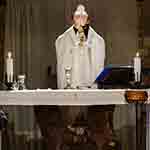
In a discussion I observed about a liturgical practice, someone criticised a priest (who affirmed this particular practice) for not implementing it in the parish he has (relatively-recently been appointed to have) oversight over.
I was really taken by his reply:
My parish is not a personal vanity project.
There is much to reflect on here.
I have written previously about different “levels” of liturgical practices/requirements/rubrics. Obviously, if a priest (or bishop – I won’t keep repeating “or bishop”) comes to a community which is used to a worship practice which is invalid, the priest changes that immediately. But, at the other end of the spectrum, if a priest arrives at a community and they do things slightly differently, but well within what is acceptable/appropriate, then changing things becomes a pastoral more than liturgical discussion. Even changing things from having been invalid to what is required for validity needs pastoral agility.
My parish is not a personal vanity project.
Yes – the presider is the one who oversees the whole service:
The choices of variant material either by addition or by omission shall normally be made by the presiding priest. [A New Zealand Prayer Book He Karakia Mihinare o Aotearoa (NZPB/HKMA) page 517.]
BUT – you noticed the “normally”. Pastoral sensitivity is required…
Fascinatingly, in this Anglican Church of Or, when using A Form For Ordering the Eucharist (NZPB/HKMA pages 511-514):
This rite requires careful preparation by the presiding priest and participants. (page 511)
When General Synod Te Hinota Whanui (GSTHW) changed the use of this rite, removing that it is “not for the regular Sunday Celebration of the Eucharist”, it explicitly put – some may not have noticed – “careful preparation” into bold type. All participants have an ownership of this rite.
Liturgy is Common Prayer – it is not the private possession of the priest (or bishop). Liturgy is not the clergy’s personal vanity project.
BUT
When GSTHW authorised the much sloppier An Alternative Form for Ordering the Eucharist, it abandoned this important liturgical principle:
In the Anglican Church of Or’s An Alternative Form for Ordering the Eucharist EVERYTHING is “at the discretion of the minister conducting the service”. The priest can choose any Eucharistic Prayer authorised anywhere in the Anglican Communion – and EVERYTHING else is created/sourced/decided “at the discretion of the minister conducting the service”. Welcome to the Anglican Church of Or. Welcome to pastoral issues that regularly ask for my response.
Let me conclude with a funny story:
Two vicars had been (too) long in their respective parishes. The theology and churchmanship of both parishes was broadly middle of the road, and the bishop decided to refresh both parishes and both clergy by having them swap parishes. After the first service, the bishop was inundated with complaints from both parishes. The complaints against both priests were the same: he was introducing high-church practices that rode roughshod over the general tenor of the parish until then. The bishop was confused – how could both parishes feel like this. The bishop investigated. Long story short: one parish was used to administering communion left to right, the other right to left. The change was seen as the high-church thin end of the wedge to overhaul of everything they held dear, and so they voiced their discontent at the start.
If you appreciated this post, consider liking the liturgy facebook page, using the RSS feed, and/or signing up for a not-very-often email, …
Instagram’s @liturgy is the new venture – if you are on Instagram, please follow @liturgy.




Makes you think! I’m a bit “high church” myself – influenced, I suppose, by my wife who is a Roman Catholic. We had an AngloCatholic Vicar for many years, then he left and his female deputy took over during the interregnum. She is half-way to being a Protestant. Both provide my needs – the Gospel and the Eucharist – that’s all I ask. The rest comes from the loving congregation.